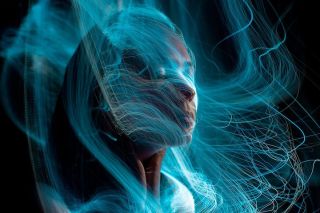Creativity
The Arc of Creativity
A cognitive journey from divine whispers to algorithmic insight.
Posted November 1, 2023 Reviewed by Kaja Perina
Key points
- Creativity's perception has evolved from divine endowment to individual genius.
- The industrial age shifted creativity towards pragmatic problem-solving, responding to challenges
- The digital age made creativity a networked, collective endeavor, facilitated by the internet.
- AI raises questions about creativity, bringing it full circle to its enigmatic, almost mystical origins.

The question "Where does creativity live?" has been a philosophical enigma that has captivated human inquiry for centuries. From the stroke of a painter's brush to the algorithmic complexities of a neural network, the spectrum of creativity has broadened, leaving us in a contemplative maze.
Is the nature of creativity changing, or is it the medium that facilitates creativity that's evolving? To answer this question, let's look at the origins of thought, the primordial soup from which creativity emerges.
Creativity as Divine Inspiration
In ancient times, the concept of creativity was deeply entwined with notions of divinity and the mystical. Creativity was not just an act of human imagination but a divine endowment, a whispered secret from gods, muses, or celestial beings. Within this context, the act of creating was seen as an external intervention rather than a product of human endeavor. Whether it was the muses of Greek mythology who inspired epic poetry and music, or the Vedic rishis in ancient India receiving hymns through divine transmission, the source of creative insight was consistently located outside the human sphere.
In these cultures, artists, poets, and even inventors were seen less as individual geniuses and more as conduits through which cosmic intelligence flowed. The Oracle of Delphi serves as a striking example; revered in ancient Greece, the Oracle was believed to channel the god Apollo, providing prophecies and wisdom that were considered products of divine creativity. Similarly, in many ancient Egyptian myths, artistic and architectural marvels like the pyramids were attributed to gods or divine kings, essentially framing humans as the implementers of celestial blueprints.
Therefore, in ancient times, creativity was perceived to reside in a realm far removed from human cognition. It was an ethereal phenomenon, an extension of cosmic or divine designs and will, temporarily inhabiting human vessels to fulfill a purpose far grander than mere artistic or intellectual expression.
The Internalization of Creative Genius
During the Renaissance, the locus of creativity shifted dramatically inward. Artists such as Leonardo da Vinci and Michelangelo were not seen only as conduits of divine messages but as individual wellsprings of unparalleled ingenuity. The origins of their creative thoughts were perceived as inherently human, nestled within the complex neural circuits of their gifted brains.
During the Renaissance, the concept of God remained significant but underwent transformation. While the period is known for its emphasis on humanism and individualism, religious themes were still pervasive. Artists depicted biblical themes, blending humanistic ideals with religious beliefs. While scientists such as Copernicus and Galileo challenged religious doctrines with their discoveries, the era represented a complex interplay between the secular and the divine, rather than a break from religious tradition.
Creativity within Constraints
During the industrial era, creativity shifted towards problem-solving within constraints, largely driven by rapid technological advancements and the needs of mass production. Here, the essence of creativity was manifested in inventions that had immediate practical applications. Take, for example, the cotton gin invented by Eli Whitney, which revolutionized the way cotton was processed and had a profound impact on the American South's economy. Similarly, James Watt's improvements to the steam engine not only optimized efficiency but also enabled its usage in various industries, from textile manufacturing to transportation. In the realm of architecture, the Eiffel Tower serves as another potent symbol of industrial pragmatism.
During this period, the creative thought was often reactionary, responding to immediate challenges such as resource scarcity, labor efficiency, or economic pressures. This was a departure from the Renaissance view of creativity as an individual's divine or innate genius. Instead, industrial pragmatism saw creativity as an evolutionary tool for adaptation and problem-solving, a skill that resided in humanity's ability to manipulate their environment for survival and progress.
Collaborative and Networked Creativity
In the digital age, creativity expanded beyond the realm of individual minds to become a communal venture, facilitated by the unprecedented connectivity of the internet. The concept of "open source," epitomized by platforms like GitHub, allows coders from around the world to contribute to a single project, effectively decentralizing the creative process. Similarly, the rise of social media platforms like Instagram and YouTube has democratized artistic expression, allowing anyone with a smartphone to become a content creator.
Notably, Wikipedia stands as an example of crowd-sourced knowledge and creativity, where a global community of volunteers contributes to an ever-expanding repository of human understanding. In music, platforms like SoundCloud and Spotify have transformed the traditional music industry by giving independent artists a platform to share their work and find an audience without the need for record labels.
In the sciences, collaborative tools and databases, such as arXiv and Google Scholar, have facilitated faster dissemination and critique of research, speeding up scientific innovation. Similarly, platforms like Kaggle have turned data science and machine learning into community endeavors, where complex problems are open-sourced for solutions from anyone capable of providing them.
In this interconnected digital ecosystem, the origin of creative thought becomes increasingly complex to pinpoint. Is a Wikipedia article the product of a single insightful contributor, or does it represent a more complex interplay of collective intelligence? Does a viral meme, born from an obscure online forum but propagated and modified by thousands, reside in the mind of its original creator or in the collective cognitive space of the internet?
This era amplifies the view that creativity is not just an individual endeavor but a networked phenomenon. Creative thought has evolved into a complex interplay of ideas flowing through a global, interconnected web of minds, making the digital age a revolutionary chapter in the ever-shifting narrative of where creativity resides
The Cognitive Interface
As we come to terms with the advancements in Large Language Models like GPT-4 and GPT4V, we need to ask: Where do these models "think?" Is their "creativity" a mere manifestation of coded algorithms, or is it a new frontier? Unlike the individual genius or collective hive-mind, the "thoughts" of AI models arise from complex mathematical functions and probabilistic predictions.
This evolution places creativity in a unique position: a symbiotic relationship between human intuition and machine computation. But can we say creativity "lives" in the machine if the origin of its "thoughts" is fundamentally different from ours? Perhaps it's more apt to say that creativity now lives in the dynamic interface between human and machine cognition—a collaborative space where thoughts, whether born from neurons or algorithms, fuse to produce novel ideas.
A Mysterious Full Circle
Yet in the context of sophisticated AI models, there's a sense that creativity has come full circle in a mysterious, almost poetic, manner. Starting from sacred altars of divine inspiration, we moved to the cerebral architecture of human genius, and then to the collaborative networks of our digital age. Now, we find ourselves grappling with the algorithms and databases of machine learning models, a realm where the line between computation and cognition becomes blurred.
Remarkably, as we explore AI's role in creative processes, we encounter a layer of enigma similar to that of divine creativity in ancient times. Just as divine creativity was an ethereal phenomenon, external to human cognition but deeply impactful, the "creativity" of AI models like GPT-4 possesses a form of "otherness." Though born from human ingenuity and data, these models generate outputs that often perplex and surprise us, making us ponder the source of their "insight." Are we on the verge of attributing a new form of "mysticism" to the machine? It seems as though we've spiraled back to a place where creativity is once again perceived as something both external and extraordinarily complex, akin to the divine origins ascribed to it in ancient civilizations.
The task ahead is clear: to continue to explore, understand, and define this fascinating interplay between varying cognitive origins as we usher in a new era of hybrid creativity. This remains essential for navigating the ethical, philosophical, and practical dimensions of a landscape where the lines between human and machine, between origin and manifestation, are increasingly blurred. Yet the search for the muse goes on.




